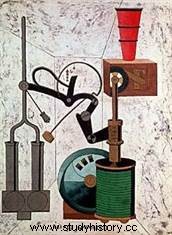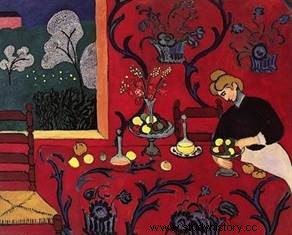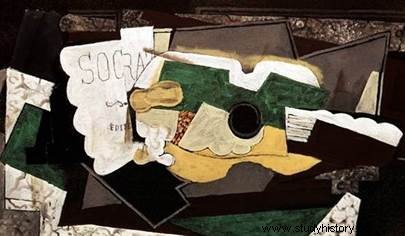 From the middle of the 19th century, artistic inspiration broke with figurative art, antique themes and the classicism:the paintings of natural landscapes by Degas, Monet or Renoir inaugurated the “impressionist” movement. Later, the influence of Paul Cézanne on the painting of the beginning of the 20th century is decisive. All artists refer to him. Far from imitating it, they innovate more and more quickly, so that several currents follow one another in the space of a few years:fauvism, cubism...
From the middle of the 19th century, artistic inspiration broke with figurative art, antique themes and the classicism:the paintings of natural landscapes by Degas, Monet or Renoir inaugurated the “impressionist” movement. Later, the influence of Paul Cézanne on the painting of the beginning of the 20th century is decisive. All artists refer to him. Far from imitating it, they innovate more and more quickly, so that several currents follow one another in the space of a few years:fauvism, cubism...
Before 1914:Fauvism
Fauvism is considered the first artistic revolution of the 20th century. This current appeared at the beginning of the 20th century. He is represented by a group of painters grouped around Henri Matisse:André Derain, Maurice de Vlaminck and Albert Marquet. Its innovative character is mainly based on the desire to abandon visible reality in favor of a subjective evocation of subjects through the use of pure color.
 At first, Matisse was influenced by Gauguin, Cézanne and Toulouse-Lautrec. His style asserted itself around 1905. Drawing became concise and perspective was abandoned, while color emerged with violence and expressiveness. He creates a vast canvas called La Joie de vivre, a painting in which he outlines the color with a thick line. During the war, Matisse was in Morocco where he attempted new pictorial experiments close to cubism (Les Marocains, 1916 ).
At first, Matisse was influenced by Gauguin, Cézanne and Toulouse-Lautrec. His style asserted itself around 1905. Drawing became concise and perspective was abandoned, while color emerged with violence and expressiveness. He creates a vast canvas called La Joie de vivre, a painting in which he outlines the color with a thick line. During the war, Matisse was in Morocco where he attempted new pictorial experiments close to cubism (Les Marocains, 1916 ).
Cubism, from Braque to Picasso
Like the Fauvist painters, the Cubists no longer seek to represent reality with a concern for verisimilitude. They interpret it by a disruption of the forms that their emotions command. Cubist paintings are rigorously constructed, often with the help of mathematics. They therefore appear as the result of intellectualization, unlike the works of Fauve painters which result from the impulsiveness of their author. Shapes are broken down and divided into angular geometric shapes, cubes. The color range is reduced to a few relatively dull tones (blue, gray, brown or beige). The genres practiced are limited to portraits and still lifes.
 At the origin of this current, we find the French Georges Braque and a Spanish painter living in Paris since 1904 , Pablo Picasso. Guillaume Apollinaire presents and defends them within the framework of his art criticism activities. He coined the term "cubism" in 1911. Since adolescence, Picasso has possessed an incredible talent, even in the academic register. After a “blue period” (1901-1904) and a “pink period” (1905-1906), he produced Les Demoiselles d’Avignon (1906-1907) , an array that acts as a manifesto. The primitive arts inspire in him a purification and a schematization of forms. He quickly detaches himself from it to turn to pure geometrisation. Braque comes from fauvism. Inspired by Les Demoiselles d'Avignon, he laid the foundations of Analytical Cubism (1910-1912). It's about dissecting the shapes to show their different aspects.
At the origin of this current, we find the French Georges Braque and a Spanish painter living in Paris since 1904 , Pablo Picasso. Guillaume Apollinaire presents and defends them within the framework of his art criticism activities. He coined the term "cubism" in 1911. Since adolescence, Picasso has possessed an incredible talent, even in the academic register. After a “blue period” (1901-1904) and a “pink period” (1905-1906), he produced Les Demoiselles d’Avignon (1906-1907) , an array that acts as a manifesto. The primitive arts inspire in him a purification and a schematization of forms. He quickly detaches himself from it to turn to pure geometrisation. Braque comes from fauvism. Inspired by Les Demoiselles d'Avignon, he laid the foundations of Analytical Cubism (1910-1912). It's about dissecting the shapes to show their different aspects.
This desire is inspired by scientific discoveries, such as that of the atom. Picasso and Braque produced the first cubist collages in 1912. They also launched a new phase, synthetic cubism (1912-1925). Plans, shapes and colors are synthesized, which unifies the space. More conceptual themes inspire the constructions. Picasso and Braque embark on a more instinctive painting. They influence Juan Gris, a Spanish painter from the School of Paris.
The birth of abstraction
Painters of the early 20th century paved the way for abstraction by increasingly detaching themselves from a realistic representation of the real world. If the cubists conceptualize reality more and more, the abstract painters detach themselves completely from it and offer works at the antipodes of figurative art. The first abstract watercolor is a work by Frenchman Francis Picabia, Caoutchouc (1909) . Another painter of Russian origin evolves in the same direction, Wassily Kandinsky. Painting becomes a pure plastic exercise.
As early as 1911, Robert and Sonia Delaunay expressed their feelings and thoughts through bright colors that often formed intertwined discs or parts of discs. Sonia Delaunay notably illustrates La Prose du Transsibérien et de la petite Jehanne de France by Blaise Cendrars around 1913. Finally, two foreign painters based in Paris participated in this pictorial evolution:the Czech Frantisek-Kupka, notably with his Vertical plans (1912-1913), and the Dutchman:Piet Mondrian. Between 1931 and 1936, the association of artists Abstraction-Création devoted itself to the defense and promotion of abstract, non-figurative art.
To go further
- Cubism, an aesthetic revolution:Its birth and influence, by Serge Fauchereau. Flammarion, 2012
- Cubism:1907-1917. Editions Beaux-Arts, 2018.
- History of abstract painting, by Jean-Luc Daval. Hazn, 1998.
